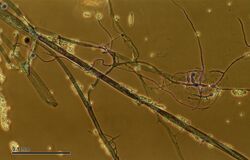Biology:Thamnidium
From HandWiki
Short description: Genus of fungi
| Thamnidium | |
|---|---|

| |
| Scientific classification | |
| Domain: | Eukaryota |
| Kingdom: | Fungi |
| Division: | Mucoromycota |
| Order: | Mucorales |
| Family: | Mucoraceae |
| Genus: | Thamnidium Link (1809) |
| Species | |
|
Thamnidium anomalum | |
Thamnidium is a genus of fungi belonging to the family Mucoraceae.[1]
The genus was circumscribed in 1809 by Johann Heinrich Friedrich Link.[1]
Thamnidium molds are key participants in the aging process for dry aged beef, producing protease and collagenase enzymes that naturally tenderize the meat.[2] Thamnidium forms pale grey patches of mold called 'whiskers' on fatty areas of a carcass or cut during the aging process.[3]
The genus has also been implicated in the spoiling of meat in cold storage, alongside other fungal genera such as Acremonium, Mucor and Rhizopus.[4]
References
- ↑ 1.0 1.1 "Thamnidium". https://www.mycobank.org/page/Name%20details%20page/field/Mycobank%20%23/20569.
- ↑ "Dry Aged Steak: Why Dry Age Meat?". https://www.theagingroom.com/news/dry-aged-steak-why-dry-age-meat.
- ↑ "Thamnidium - an overview | ScienceDirect Topics". https://www.sciencedirect.com/topics/agricultural-and-biological-sciences/thamnidium.
- ↑ Fung, D. Y. C. (2014-01-01), Dikeman, Michael; Devine, Carrick, eds. (in en), MICROBIOLOGICAL SAFETY OF MEAT | Yeasts and Molds, Oxford: Academic Press, pp. 395–404, ISBN 978-0-12-384734-8, https://www.sciencedirect.com/science/article/pii/B978012384731700043X, retrieved 2022-03-07
Wikidata ☰ Q10694977 entry
 |

